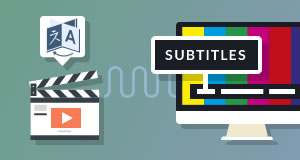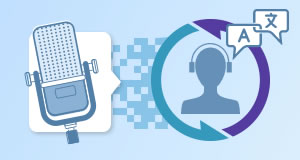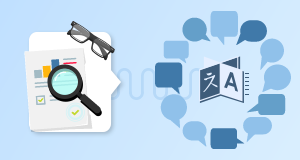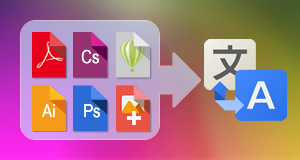
Customers appreciate being the focus of your attention; a piece of translated text on an otherwise English-looking webpage, menu, document or asset is unlikely to grab their attention and make them feel valued. You spend a lot of time, money and resources creating a carefully crafted marketing piece, complete with your content, branding and style for your core language, so why not make the most of it and create a localised replica to entice your international contacts quickly and cost-effectively?
Typesetting is usually a cost-effective way of localising more than just the text content of your document. A skilled typesetter can reproduce your source document and make it look as though you created it in the target language by carefully resizing the images, fonts and spacing etc. to fit the given space and design. It’s important to consider that translations/copywritten texts have a tendency to dramatically expand or decrease in size, depending on your chosen language(s). This often has a significant impact on the source design you have created, as the text content simply may not fit in the space. This is one of the core reasons why clients opt for multilingual editors to post-process their work.
Although usually considered a service for software such as Adobe InDesign, Adobe Illustrator and PowerPoint etc., typesetting is actually useful for most file types; although for Microsoft Word as an example, it would more likely be considered “post-editing” or “file tidy-up”.
You may already have a typesetter in-house. If this is the case, you should check if they are confident with multilingual typesetting, especially when it comes to right-to-left and character-based languages. Although most multilingual typesetters are not native speakers, they are accustomed to working in a wide variety of languages and have a good linguistic knowledge base, meaning that they can quickly and effectively typeset a document, usually with a 24/48-hour turnaround for most standard documents (this is a time estimate for short brochures, menus and marketing documents etc. – always check with your provider).
Multilingual desktop publishing
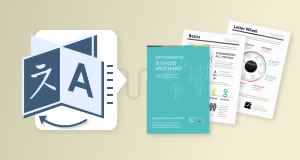
Speaking your customers' language is essential if you want to succeed in international markets. By having artwork in the target language, you can improve communication and also connect with your target audience on a deeper level that is more likely to result in conversions. Our multilingual desktop publishing service covers any desktop publishing requirements for artwork intended for use in materials such as leaflets, brochures and technical manuals. The translated content will be carefully embedded into the original artwork ensuring that your multilingual material replicates the source as closely as possible. We will require you to provide all the original source artwork in an editable format, including graphics and fonts, in order to establish the best way to go about the desktop publishing process.
Sponsored
Things to consider when localising content
There are a few exceptions and considerations you should be aware of when localising content. You can localise almost any image if you have the build source, or by recreating images and using text overlays; however, consider the following:
Source files, fonts and links – Wherever possible, it’s best to send your provider the build files used to create the original source; be it Word, InDesign or Illustrator etc. These often include sub-folders with the fonts and links (images) which were used in the source build process. These allow the typesetter to more easily re-create/edit the images with a higher speed and quality, especially when you have used images with overlaid text.
If you do not have the source files available, you should discuss this with your provider. Source files can be rebuilt; often to 99% accuracy, depending on the complexity of the file. Some images can be pulled from PDF exports you may have provided; however, the process of rebuilding documents takes additional costs and time.
Operating systems – Typesetters can usually handle requests on PC or Mac, although it’s best to make it clear if you are working on a Mac system to ensure the return package is compatible. If you have used a specific alternative platform, it is worth checking with your provider in any case, as many typesetters can handle a full complement of operating systems and platforms.
Bilingual/multilingual documents – Typesetters can provide a variety of services under the umbrella of “multilingual desktop publishing”; however, they need some instruction and guidance. You can request a bifold, trifold, bilingual or multilingual layout for your delivered document, but some basic instructions are required. If this is not the layout of the source, a document will not automatically be delivered with this specification unless it is requested.
Screenshots – If you have screenshots of webpages or software which only exist in English, it makes the best sense to keep the target versions with the English screenshots too. If the webpages or software is localised already, you should look to provide localised versions of your screenshots to replace in the target languages. This is even more important for software, as although a translation company can easily translate the text of the image, it may not be in-line with the actual software, thereby causing confusion for the reader.
Graphs and stats – The statistics contained in your source document or the currency/format they are displayed in might not make a lot of sense to your target audience. You should consider how you want to present this information. Do you want to simply translate it or do you want to provide local data?
Contact details – You want to ensure that your potential customers can contact you, should they have any questions. If you have a local office or contact number/e-mail, you should provide this information for your target copies with the relevant dialling codes and formatting.
Local rules and regulations – Depending on the content, it may make sense to localise the terms and conditions, and to convert the given figures to euros/dollars etc. For example, you may have a minimum returns value £30, whereas in France, this may be 40€. Some terms may be internally set by your company, other more complex terms may have a legal impact such as the complaints process, time periods to return goods, and health and safety acts etc. These should be checked by a legal team, as although translation agencies are able to translate legal content, they are not usually in a position to change content. In such cases, you can either have your source terms checked by a legal entity from the relevant target location prior to translation, or you can translate the source and then have a legal entity check the documents for compliance. The latter is often a more expensive, albeit a more thorough, approach as the translation is checked in the process for accuracy.
Typesetters are not just typesetters!
Typesetters often offer a number of services which don’t strictly fall under the common concept of multilingual desktop publishing. Some of these services are listed here:
Design – If you feel your documents could do with an upgrade, perhaps see what your typesetters can produce. Editors spend a lot of time recreating documents, however, they often can provide great designs for your concept/style guide too. Simply give them an idea of what you have in mind or ask them to go completely free-style. All they need from you is the text and any images/logos etc. that you want to use.
It is also possible to create templates for ongoing requirements which are suitable for providing PDF outputs.
Layout updates – If you have made a decision to update your single page layout to a trifold layout as an example, typesetters can update your in-language copies too. This is quoted on a case-by-case basis and is usually a quick and cost-effective service.
Image/content text extraction – If you have a document which has perhaps been scanned or handwritten for example, you may have difficulties editing it. Typesetters often offer text extraction services which use a combination of OCR (optical character recognition) tools and manual typing to extract the content for you. This can either be provided in a table or a typed-out document roughly following the source document. This is depending on the request and the document.
Conversion to INDD/Illustrator, etc. – If you have designed something in Word and you want it moving into an InDesign file, typesetters can offer this service also. They can either keep your existing structure or update the layout. This can be combined with the “design” service mentioned above to create a more custom delivery.
I hope this has given you a useful introduction to multilingual desktop publishing. To learn more about our multilingual desktop publishing service, see here.
Samantha Brazel
Latest posts by Samantha Brazel (see all)
- An introduction to SEO-localisation - March 23, 2023
- 3 tips for achieving high-quality translations - March 21, 2023
- 3 tips to make website translation more efficient - May 18, 2022
